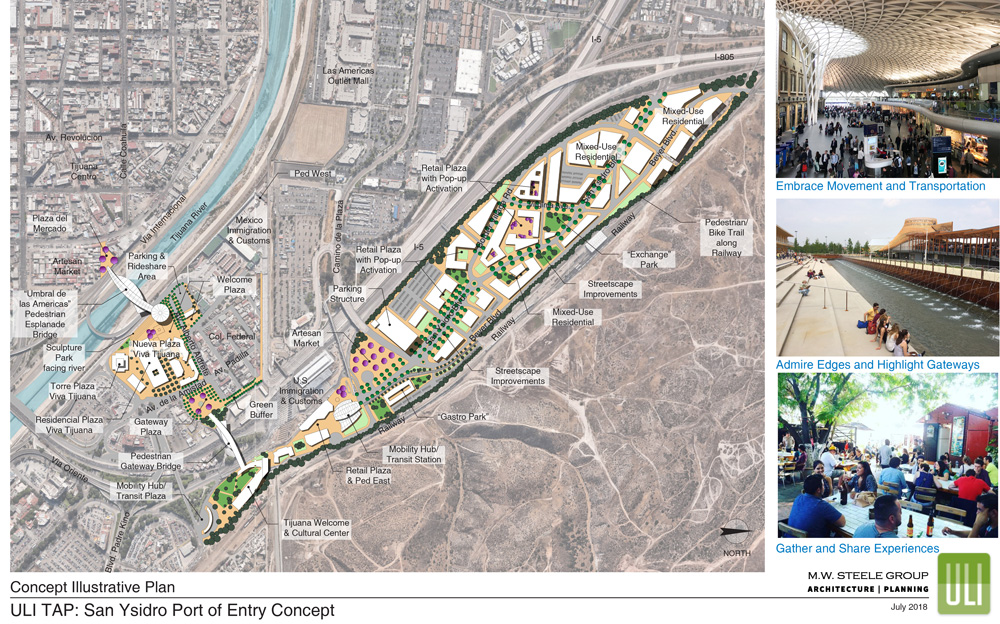Medical tourism and binational retail centers are among the myriad opportunities presented by property surrounding the San Diego–Tijuana border crossing, said members of a panel discussion organized by ULI San Diego–Tijuana in October. But the San Ysidro crossing—the busiest border crossing in the world—remains a daunting, congested funnel for binational business, panelists said.
“The problem of crossing the border has to be addressed,” said Gary London, senior principal of London Moeder Advisors, a San Diego–based consultancy.
Panel members participated in a recent technical assistance panel (TAP), organized by ULI San Diego–Tijuana, to examine the challenges and opportunities presented by development of the area around the border crossing. A report resulting from the TAP, Cross Border Visioning: An Exploration of a United Cross-Border Experience, focused on a wide array of specific improvements to streets, sidewalks, parks, signs, and landscaping to help transform the border into a more welcoming environment.
The border section “should be a lot more attractive, and it has opportunity to be more attractive,” said discussion moderator Diego Velasco, principal of M.W. Steele, an architecture and planning firm. Tijuana has been unable to connect the development and new energy of the central part of the city to the border, which is attracting more millennials and hipsters, Velasco said.
The scale of the opportunity is huge, says the report, noting that the region boasts a shared economy of $230 billion and a combined workforce of 3.8 million people. “The Mexican real estate community is also making significant investments in residential, commercial, and medical projects that will change the economic complexion of the city,” the report says.
Medical tourism represents one of the biggest opportunities, said Carolina Chavez, director of binational affairs for SIMNSA, a health care provider. The ease of crossing the border for less-expensive medical procedures already makes medical tourism a $700 million business in Baja California, she said. “You can’t replicate it anywhere,” Chavez said. “The [business] model is the border.”
Developer Grupo Abadi built NewCity Medical Plaza, a medical tourism–focused project in Tijuana, located 50 yards (500 m) from the border to take advantage of the “huge opportunity,” said Isaac Abadi, chief executive officer of the project. The eight-acre (3.2 ha) NewCity complex is envisioned as a live/work hub that including residences.
Tijuana has an opportunity to play an important role as an alternative housing market for California, Abadi said. A luxury two-bedroom apartment in Tijuana, less than an hour’s drive from downtown San Diego, might cost $300,000, less than half the price for a similar residence in San Diego, he said. “It’s a pretty good option for affordable housing for the U.S.,” he said.
But the flow of Americans buying homes in northern Baja has dried up because of the many issues at the border, London said.
In Ensenada, south of Tijuana, Abadi’s company built the first tower of a residential complex targeting U.S. buyers but has not moved forward with the second tower, Abadi said. The second-home market in the area is “not booming at all,” he said.
For residential projects trying to attract U.S. buyers, “the biggest problem is financing is so high,” Abadi said. “It is not accessible for the U.S. customer.”
Most of the opportunities on the border have been developed by Mexicans heading north, not Americans going south, London noted. “It’s a one-way street,” he said. “Where we have failed is in creating more equity in terms of the balance of the relationship. It’s a huge opportunity we have missed.”
The flow of consumers heading north has not translated into new development along the border and the U.S. city of San Ysidro, London said. One of his clients is examining the possibility of a food hall on the north side of the border as developers look for new concepts to attract the millions of people who cross the border each year headed north for business, shopping, and entertainment.
“The opportunity for us is to add more jobs” in San Ysidro and develop the area as more of a destination, London said. The area has been unable to translate the flow of people living on the Mexico side of the border who come to shop in the United States into new developments in San Ysidro, London said.
The elephant in the room is the crime and security issues in Mexico, London said. But, overall, he said he sees that “changing in a positive way.”
The TAP review committee took a holistic approach to the issues facing the border, including placemaking, development, and financing. The report makes specific recommendations regarding sidewalks and pedestrian-oriented landscaping, binational development initiatives, and the addition of new public attractions to help make the border a destination.
The report recommends a “P5” approach to financing, adding nonprofits, philanthropic groups, and “people” resources to traditional public/private partnerships. The redevelopment of the Tijuana crossing could be a model for other binational border areas, the report concludes.





